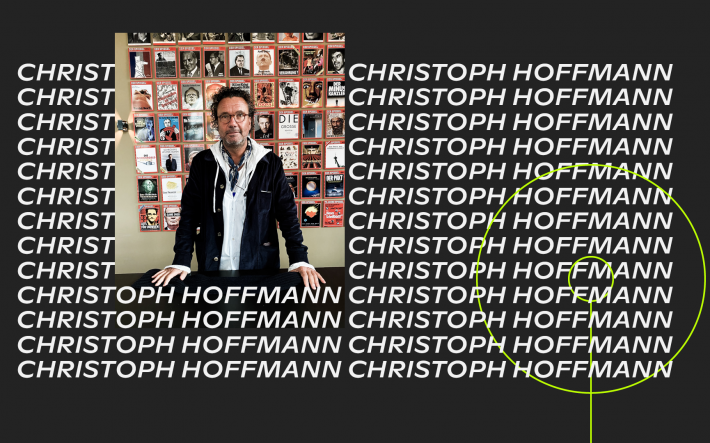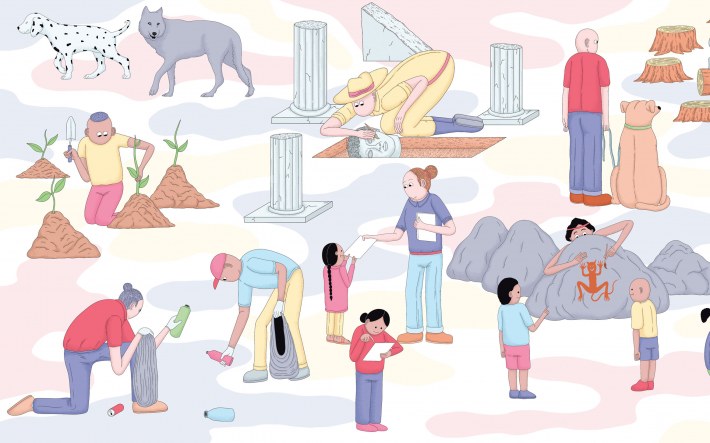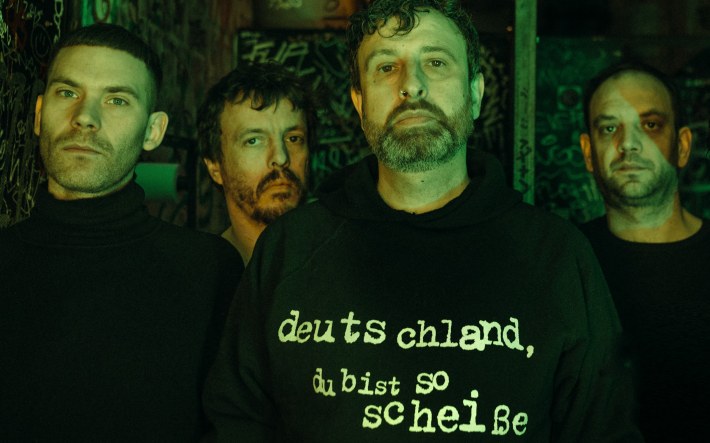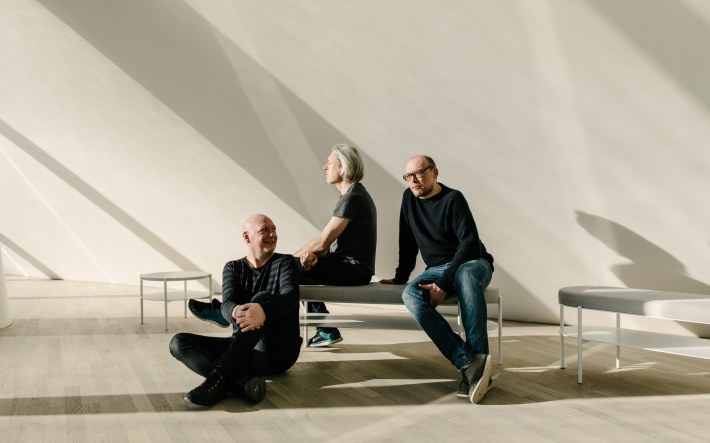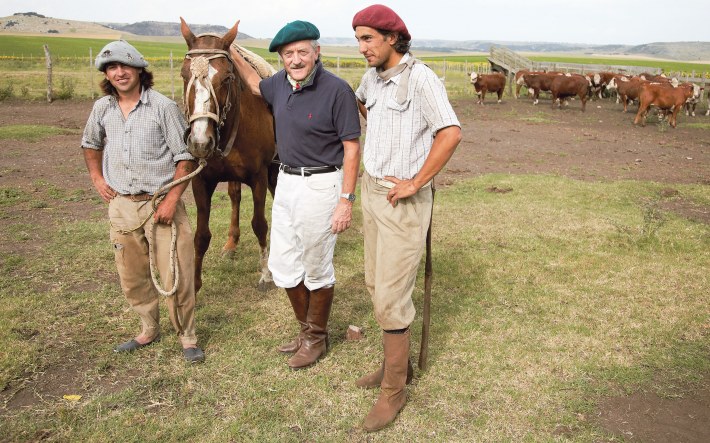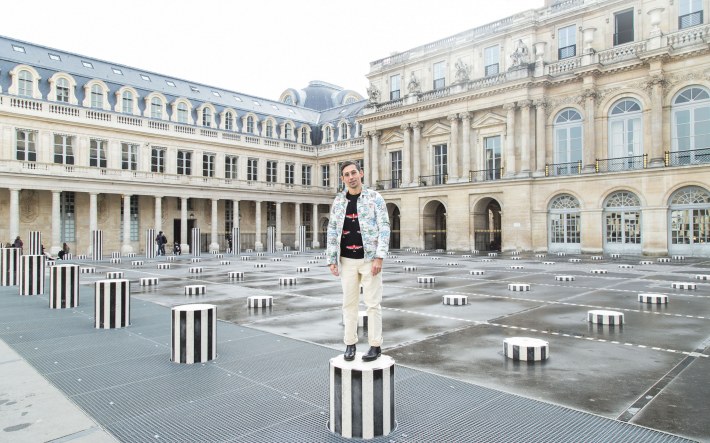Style Tracks.
Louis Philippe de Gagoue likes to deviate from compartmentalisation in his life and his work—which is what makes the photographer and style icon, who spends his time between the Ivory Coast and Paris, so successful.
Louis Philippe de Gagoue takes fashion photos filled with beauty — and is always the most beautiful himself. This is evident to everybody who has scrolled through his social media profiles. Louis in brown leather trousers with a royal-blue cummerbund in Rome. Louis in an asymmetrical camel-coloured tailored suit in Casablanca. Louis in a black ensemble with a box-red belt masterfully looped around his waist in Paris. Past decades, foreign cultures, literature and film — Louis can draw inspiration from anything. ‘The most important source, however, is studying your inner self,’ he says.
Louis was born in 1991 in the Ivory Coast, his father’s home country, and his mother comes from Cameroon. ‘When I looked through my family’s photo albums as a child, I noticed how well dressed my family always were. My father, my mother, my aunties were looking so chic and elegant, very well dressed in beautiful gowns, hats, gloves. My father was such a dandy,' he says in a buttery, soft accent. ‘I thought to myself, “I want a life like that one day.” Seeing beautiful things, smiling, parties, drinking champagne, traveling around the world, meeting people from all over the world.’ That’s how he got his start in fashion — from his fascination in people and their clothes. Today, Louis splits his time between the Ivory Coast and Paris, where he is represented by the renowned agency Artsphere.
As a photographer? Not exactly. Louis is considered to be more of an artist who guides avant-garde, independent magazines, or international editions of well-known magazines like Vogue, in their fashion imagery, from concept and styling right up to the technical factors. He takes on both the photographer and stylist roles in almost all of his projects. Quotes about his African home, references to European style, and visions of futuristic fashion merge into a succinct aesthetic that addresses the themes of culture and cultures using hypermodern imagery.
Afrofuturism? ‘In a modern context, I don’t feel myself as a part of this movement. I’m proud to be African and a child of this beautiful place, but I don’t want to be associated with this movement because my inspirations aren’t only coming from Africa — I find beauty in all the different cultures around the world,’ says Louis. The cultural movement known as Afrofuturism since the late 1990s reinterprets creative works — ranging from science fiction to fantasy, from historical novels to realism — in terms of the reality of life and life plans of the African diaspora, but is a reductive way to describe Louis’s work, in his opinion. ‘I see myself as more of a world citizen,’ he says. However, he does respect the political genre — which is becoming increasingly sought-after in the fashion industry, and can involve all facets of art, from literature to paintings and film — just like he respects the ‘sapeurs’, another movement that originated in Africa.
Since the early 1920s, sapeurs have dressed in a sophisticated and elegant way – partially in direct contrast with their sometimes precarious circumstances in life. Starting in the 1960s, the playful fashion movement has turned into a political one, which simultaneously determines and provides an ironic response to the dogma of the post-colonial era. ‘I have a great deal of respect for sapeurs — they took risks,’ says Louis. ‘At the end of the day, we live in a society where people are forced to conform and follow commercially influenced principles.’ However, he doesn’t feel a deeper connection to the ideology and fashion of the sapeurs. ‘I’m just me, anything else is just a label. And labels exist to let other people categorize you. I don’t categorize myself, I’m just a free bird.’
In fact, Louis lives in a bubble that he wishes to invite the people viewing his photographs into. His website says: ‘For him, photography is a form of utopia — an escape from our everyday world that is eaten up by war and conflict.’ The photographer wants to transport his audience away from this version of the world. ‘I have selective perception and a selective memory as well,’ Louis says, laughing. ‘If something interests me, I take it all in. If something doesn’t interest me, I close my eyes so as not to see it.’ Nevertheless, Louis knows all too well what’s going on around him. For years now, discourse on the underrepresentation of people of African descent in the Eurocentric fashion industry — including models, designers, photographers — has been ramping up.
However, things are slowly changing. Designers like Kenyan-born Sam Jairo Omindo have been helping African fashion shows, such as Fashion Week in Addis Ababa in Ethiopia or the International Fashion Festival in Morocco, to gain significance. Additionally, the label Super Yaya from Louis’s home country, Ivory Coast, has made a niche for its trendy streetwear, somewhere between Afrofuturism and digital-savvy Post-Internet Art. And yet: ‘I know that there are still a lot of narrow-minded people around, of course — even in the fashion industry.’ says Louis. ‘But I don’t like to be the victim. I’ve never seen myself as a victim and will never let myself be made into one.’
As such, COMPANION asked Louis to make a playlist that is as hard to pigeonhole as he is himself.
→ louisphilippedegagoue.com



